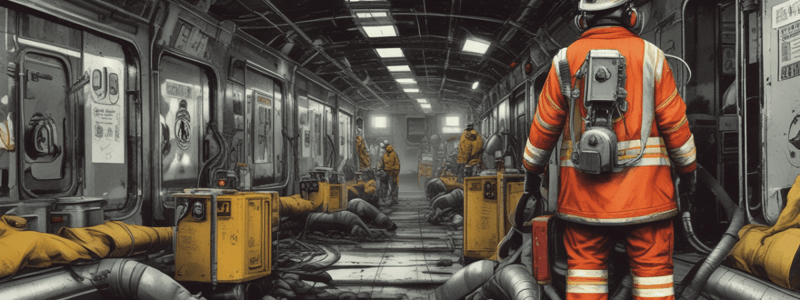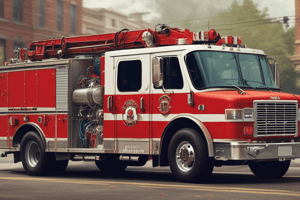Podcast
Questions and Answers
Which senses are considered high-risk when identifying hazardous materials?
Which senses are considered high-risk when identifying hazardous materials?
- Sight, hearing, and touch
- Sight, smell, and hearing
- Smell, touch, and taste (correct)
- Vision, touch, and taste
What should be consulted first when finding hazmat information in the ERG?
What should be consulted first when finding hazmat information in the ERG?
- Potential Hazards (correct)
- Protective Clothing
- Emergency Contact Information
- Public Safety
What is the primary use of the orange color-coded pages in the ERG?
What is the primary use of the orange color-coded pages in the ERG?
- To identify hazardous materials (correct)
- To explain protective clothing requirements
- To provide evacuation routes
- To list emergency contact numbers
Which of the following is NOT a key area addressed in the Public Safety topic of the ERG?
Which of the following is NOT a key area addressed in the Public Safety topic of the ERG?
What should you do first upon arriving at a hazmat scene?
What should you do first upon arriving at a hazmat scene?
Which of the following hazards is NOT related to hazardous materials?
Which of the following hazards is NOT related to hazardous materials?
Why is it important for responders to inform others about incident conditions?
Why is it important for responders to inform others about incident conditions?
What is a key requirement for using protective clothing during a hazmat incident?
What is a key requirement for using protective clothing during a hazmat incident?
Which class of hazardous materials includes nuclear waste and radioactive medical materials?
Which class of hazardous materials includes nuclear waste and radioactive medical materials?
What type of substances are categorized as Class 8 hazardous materials?
What type of substances are categorized as Class 8 hazardous materials?
Which of the following is NOT considered a Class 9 miscellaneous dangerous good?
Which of the following is NOT considered a Class 9 miscellaneous dangerous good?
What role does occupancy play in understanding hazardous materials?
What role does occupancy play in understanding hazardous materials?
Which of the following examples is classified under Class 7 hazardous materials?
Which of the following examples is classified under Class 7 hazardous materials?
What is one of the main objectives during a hazmat incident?
What is one of the main objectives during a hazmat incident?
What should be done to ensure public safety during a hazmat incident?
What should be done to ensure public safety during a hazmat incident?
Why is the shape of a container involved in a hazmat incident significant?
Why is the shape of a container involved in a hazmat incident significant?
What does the standard of care refer to in a hazmat response?
What does the standard of care refer to in a hazmat response?
What does the term 'location' refer to in the context of hazardous materials?
What does the term 'location' refer to in the context of hazardous materials?
Which of the following actions should a responder avoid during a hazmat incident?
Which of the following actions should a responder avoid during a hazmat incident?
Which of the following materials is classified as a Class 9 hazardous material?
Which of the following materials is classified as a Class 9 hazardous material?
What is a critical factor when identifying hazardous materials?
What is a critical factor when identifying hazardous materials?
What is essential to prevent direct contamination during a hazmat incident?
What is essential to prevent direct contamination during a hazmat incident?
Why is it vital for a responder to assess their level of training during a hazmat incident?
Why is it vital for a responder to assess their level of training during a hazmat incident?
What should be done if the specific identity of a hazardous material cannot be determined?
What should be done if the specific identity of a hazardous material cannot be determined?
What is the primary action to take after isolating the immediate danger area?
What is the primary action to take after isolating the immediate danger area?
What determines the protective action distance during an evacuation?
What determines the protective action distance during an evacuation?
Under what circumstance should an area be evacuated?
Under what circumstance should an area be evacuated?
What is advised against for awareness-level responders during a hazardous materials fire?
What is advised against for awareness-level responders during a hazardous materials fire?
Which factor is NOT mentioned as influencing the protective action distance?
Which factor is NOT mentioned as influencing the protective action distance?
What is a key guideline for operational-level personnel facing a hazardous materials fire?
What is a key guideline for operational-level personnel facing a hazardous materials fire?
What hazards should be considered when deciding to evacuate?
What hazards should be considered when deciding to evacuate?
What should responders consult to determine appropriate evacuation distances?
What should responders consult to determine appropriate evacuation distances?
What is the primary responsibility of technician-level personnel during a hazmat incident?
What is the primary responsibility of technician-level personnel during a hazmat incident?
Which personnel can perform control of spills and leaks?
Which personnel can perform control of spills and leaks?
What should awareness-level responders do when they identify contaminated victims?
What should awareness-level responders do when they identify contaminated victims?
What are the three steps involved in the termination process of a hazmat incident?
What are the three steps involved in the termination process of a hazmat incident?
What is the focus of the incident critique phase?
What is the focus of the incident critique phase?
What action must an agency take if an officer's exposure exceeds acceptable limits?
What action must an agency take if an officer's exposure exceeds acceptable limits?
Who must have proper training and protection when controlling spills and leaks?
Who must have proper training and protection when controlling spills and leaks?
What is the role of awareness-level responders in relation to contaminated individuals?
What is the role of awareness-level responders in relation to contaminated individuals?
What should you do immediately after finding a suspicious item?
What should you do immediately after finding a suspicious item?
What is important to note when observing a suspicious device?
What is important to note when observing a suspicious device?
Why should you not definitively state that a location is safe after inspecting it for suspicious items?
Why should you not definitively state that a location is safe after inspecting it for suspicious items?
How should one approach a situation where a suspicious item is found?
How should one approach a situation where a suspicious item is found?
What is a common misconception regarding suspicious items and bomb threats?
What is a common misconception regarding suspicious items and bomb threats?
Which of the following actions is recommended when you find a suspicious item?
Which of the following actions is recommended when you find a suspicious item?
What should be avoided when handling or inspecting a suspicious package?
What should be avoided when handling or inspecting a suspicious package?
What role does gathering more details play in handling suspicious items?
What role does gathering more details play in handling suspicious items?
What should you do if you can't identify the owner of a suspicious item?
What should you do if you can't identify the owner of a suspicious item?
What is a significant risk when making definitive statements about safety at a suspicious site?
What is a significant risk when making definitive statements about safety at a suspicious site?
Flashcards are hidden until you start studying
Study Notes
Objectives of Hazmat Response
- Isolate the area without physical entry.
- Ensure public safety by keeping individuals away.
- Maintain safe distances for people, ensuring they are upwind and away from low-lying areas.
Standard of Care
- Responders must act within their training limits and available equipment.
- Public safety employees have a duty to act but must exercise caution and avoid unnecessary risks.
- Only trained personnel equipped for hazmat situations should approach potential hazards.
Identifying Hazardous Materials
- Accurate identification of hazardous material is crucial while minimizing personal risk.
- Avoid contact with hazardous substances, vapors, or smoke.
- Use shipping documents, interview involved personnel, or rely on bystanders for material identification.
- Make decisions based on awareness-level training if material identification is unclear.
Classes of Hazardous Materials
- USDOT classifies nine common hazardous materials:
- Class 1: Explosives
- Class 2: Gases
- Class 3: Flammable liquids
- Class 4: Flammable solids
- Class 5: Oxidizers and organic peroxides
- Class 6: Toxic substances
- Class 7: Radioactive substances—including nuclear waste and X-ray equipment
- Class 8: Corrosive substances—like acids and solvents
- Class 9: Miscellaneous dangerous goods—not fitting into classes 1-8 (e.g., lithium batteries, asbestos).
Occupancy and Location
- Occupancy types influence potential hazardous materials present (e.g., manufacturing, retail).
- Assess location types (e.g., industrial parks, residential areas) for risks to inform response.
- Assume hazardous materials may exist in unknown environments.
Detecting Hazards
- Observe container shape and size for hazard indicators.
- Look for signs such as pressure release, vapor clouds, chemical reactions, and casualties from a safe distance.
Risk Assessment
- Smell, touch, and taste are high-risk senses not to be used during hazardous material identification.
- Rely on visual and indirect assessment methods instead.
Emergency Response Guidebook (ERG) Usage
- Utilize the orange pages of the ERG for hazardous material identification.
- Focus on three key areas:
- Potential Hazards: Fire/explosion and health impact descriptions.
- Public Safety: Notification procedures, protective clothing requirements, and evacuation protocols.
- Emergency Response: Instructions pertaining to fire suppression, spill control, and first aid.
Public Safety Procedures
- Initial actions include activating emergency response plans and notifying other responders.
- Evacuate areas at risk, adhering to protective action distances based on material type and incident conditions.
Emergency Response Guidelines
- Awareness-level responders must avoid extinguishing fires involving hazardous materials.
- Operational personnel can employ defensive strategies if trained, while technician-level personnel can engage in offensive actions.
First Aid Protocols
- Awareness-level responders should guide contaminated victims to isolated areas without direct contact.
- Victims should await assistance from qualified personnel for decontamination.
Incident Termination Procedures
- Adhere to agency policies for terminating involvement in a hazmat incident.
- Follow OSHA's structured termination process which includes:
- On-scene debriefing about exposure risks and symptoms.
- Incident critique to evaluate strengths and weaknesses.
- After-action analysis for further improvements.
Incident Command System (ICS) Overview
- Officers utilize ICS for managing various critical incidents like vehicle crashes, hurricanes, and wildfires.
- Basic ICS structure may vary by organization but shares common elements.
- Initial response involves obtaining information from dispatch and identifying the type of incident or threat.
Initial Response Actions
- Assess the need for personal protective equipment (PPE).
- Establish the ICS and set up a command post.
- Determine resource requirements, including assistance from other agencies.
- Make decisions regarding shelter-in-place or evacuation, including routes and collection points.
Hazardous Materials Response
- Main objectives in a hazmat incident include isolation of the area, crowd control, and ensuring safety conditions (upwind positioning and avoiding low-lying areas).
- Responder's duty of care must align with their training and equipment capabilities.
- Approach hazardous material situations only with appropriate training and gear.
Identifying Hazardous Materials
- Identification is crucial and must be done without risking personal safety.
- Use documentation, shipping papers, or personnel to identify materials, avoiding contamination risks from fumes or direct contact.
- If the material cannot be identified, operate at an awareness level to mitigate potential hazards.
Classes of Hazardous Materials
- The USDOT recognizes nine classes of hazardous materials and recommends identifying hazards from a safe distance.
- Look for visual indicators like smoke, liquid leaks, chemical reactions, and signs of mass casualties.
Risk Considerations in Sensory Identification
- Smell, touch, and taste are considered high-risk senses and should never be used for identifying hazardous materials.
Emergency Response Guidebook (ERG) Usage
- The ERG is a vital resource for identifying hazardous materials during responses.
- Focus on the orange pages which provide critical information on potential hazards, public safety measures, and protective clothing requirements.
- Notification protocols include activating emergency response plans and communicating with other responders.
Bomb Threat Response
- When approaching a possible bomb threat, assess the credibility by interviewing the threat recipient and other witnesses.
- Be observant of unusual vehicles, abandoned items, and suspicious packages.
- Never definitively declare a location safe without thorough investigation to avoid liability.
Recognizing Suspicious Items
- Bombs may be disguised as ordinary objects; always verify ownership before interacting with suspicious items.
- If a suspicious item is found, prioritize evacuation and promptly report to authorities.
- Collect details about the suspicious item, including its features, and communicate findings to relevant personnel.
Overall Incident Management
- Regular updates from responding personnel are crucial for effective decision-making during incidents.
- Documentation and debriefing are essential components of response protocols to ensure lessons learned are recorded for future training and improvement.
Studying That Suits You
Use AI to generate personalized quizzes and flashcards to suit your learning preferences.




